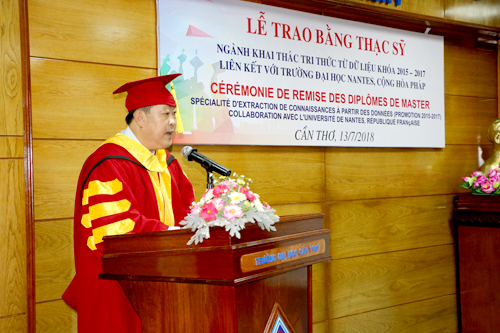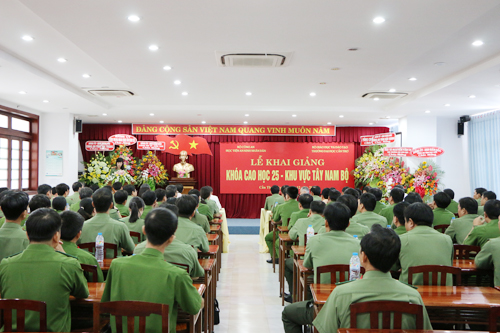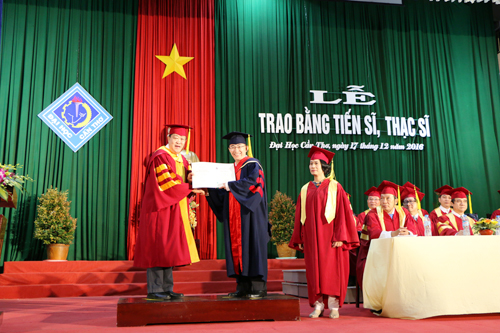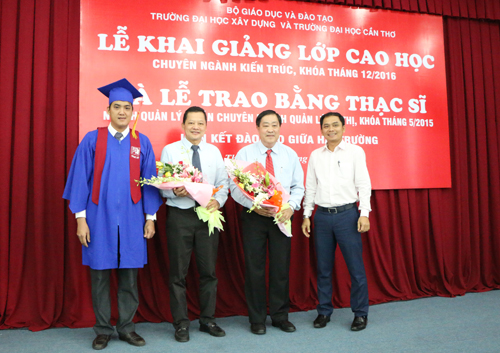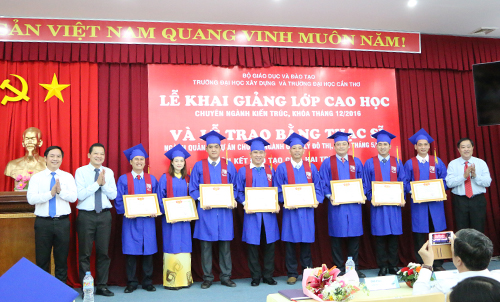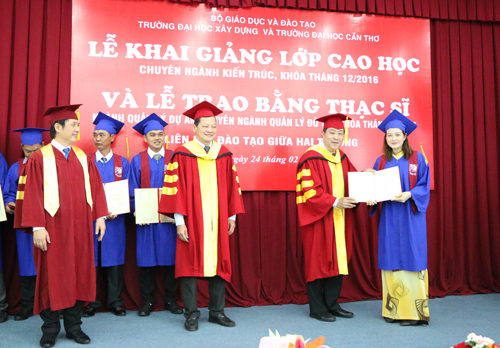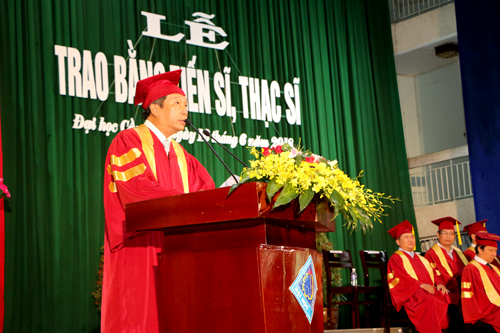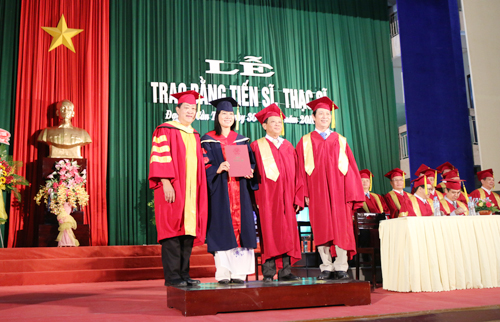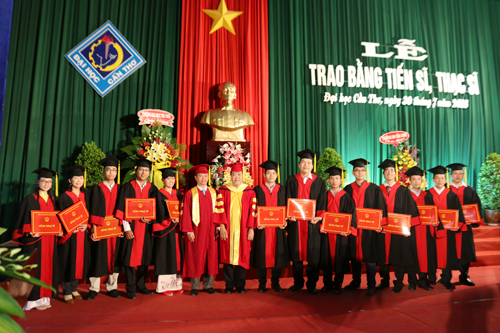 Tên đề tài: “Nghiên cứu khả năng sử dụng protein trong khẩu phần của thỏ Californian” .
Tên đề tài: “Nghiên cứu khả năng sử dụng protein trong khẩu phần của thỏ Californian” .
 Tác giả: Trương Thanh Trung, Khóa 2012 đợt 1.
Tác giả: Trương Thanh Trung, Khóa 2012 đợt 1.
 Chuyên ngành: Chăn nuôi; Mã số: 62620105. Nhóm ngành: Nông - Lâm - Ngư nghiệp.
Chuyên ngành: Chăn nuôi; Mã số: 62620105. Nhóm ngành: Nông - Lâm - Ngư nghiệp.
 Người hướng dẫn chính: PGS.TS Nguyễn Thị Kim Đông, Trường Đại học Cần Thơ.
Người hướng dẫn chính: PGS.TS Nguyễn Thị Kim Đông, Trường Đại học Cần Thơ.
- 1. Tóm tắt nội dung luận án
Luận án bao gồm 5 thí nghiệm được tiến hành tại trại thực nghiệm ở Thành phố Cần Thơ để đánh giá khả năng sử dụng protein của thỏ Californian tăng trưởng được nuôi trong điều kiện ở Đồng bằng sông Cửu Long (ĐBSCL) của Việt Nam. Thí nghiệm thứ nhất là xác định thành phần dinh dưỡng của một số loại thức ăn phổ biến dùng cho chăn nuôi thỏ ở ĐBSCL. Thí nghiệm thứ hai là xác định mức độ tối ưu của đạm thô trong khẩu phần thỏ Cailfornian tăng trưởng. Thí nghiệm thứ ba là so sánh và chọn ra nguồn đạm thích hợp trong khẩu phần thỏ Californian tăng trưởng. Thí nghiệm thứ tư là tìm mức độ lysine và threonine tối ưu trong khẩu phần thỏ Californian tăng trưởng. Thí nghiệm thứ năm là xác định mức độ năng lượng trao đổi (ME) tối ưu trong khẩu phần thỏ Californian tăng trưởng trong điều kiện nuôi dưỡng ở ĐBSCL.
Kết quả thí nghiệm 1 chỉ ra rằng hầu hết các thành phần acid amin thiết yếu và không thiết yếu của rau muống và cỏ đậu cao hơn so với của bìm bìm và cỏ lông tây. Rau lang và lá rau muống có hàm lượng CP cao và cân đối các thành phần chất xơ. Đậu nành có hàm lượng các acid amin thiết yếu và không thiết yếu thấp hơn so với bột cá, bột lông vũ và bột huyết, ngoại trừ hàm lượng methionine, glutamic và arginine.
Kết quả thí nghiệm 2, lượng CP ăn vào tăng (P<0,05) trong khi NDF, ADF và EE tiêu thụ giảm (P<0,05) giữa các nghiệm thức. Kết quả tăng trọng khác biệt có ý nghĩa thống kê (P<0,05) giữa các nghiệm thức với giá trị cao hơn (22,4; 23,3 và 23,2g/ngày) tương ứng ở các nghiệm thức CP19, CP21 và CP23. Khối lượng thân thịt, thịt đùi và thịt tuộc cao có ý nghĩa (P<0,05) khi thỏ ăn khẩu phần CP19, CP21 và CP23 trong khi lợi nhuận cao nhất là ở nghiệm thức CP21.
Kết quả thí nghiệm 3, lượng DM, OM, CP, EE, NDF, ADF và ME tiêu thụ của thỏ ở nghiệm thức đậu nành ly trích và lá rau muống cao có ý nghĩa (P<0,05) hơn các nghiệm thức còn lại. Khối lượng thân thịt và tỷ lệ thân thịt của nghiệm thức đậu nành ly trích và lá rau muống cao hơn (P<0,05) so với nghiệm thức bột lông vũ và bột huyết. Nghiệm thức đậu nành ly trích và lá rau muống mang lợi hiệu quả kinh tế cao nhất.
Kết quả thí nghiệm 4, tỷ lệ tiêu hóa của hầu hết các acid amin ở nghiệm thức 0.95-Lys cao hơn (P<0,05) so với nghiệm thức 0.85-Lys và 1.05-Lys. Ở nhân tố threonine, tỷ lệ tiêu hóa biểu kiến của hầu hết acid amin cao hơn (P<0,05) ở nghiệm thức 0.75-Thr. Tăng trọng hàng ngày của thỏ ở nghiệm thức 0.95-Lys và 0.75-Thr (22,4 và 22,2 g/ngày) cao hơn có ý nghĩa (P<0,05) so với nghiệm thức 0.85-Lys, 1.05-Lys và 0.65-Thr.
Kết quả thí nghiệm 5, tăng trọng khác biệt có ý nghĩa (P<0,05) giữa các nghiệm thức với giá trị cao nhất ở nghiệm thức ME11.5 (24.5 g/ngày). Khối lượng thân thịt, thịt tuộc và thịt đùi cao khác biệt có ý nghĩa (P<0,05) ở nghiệm thức ME11.5 với các giá trị lần lượt là 1.374, 1.049 và 412g.
Đề tài được kết luận rằng có thể kết hợp các nguồn thực liệu thức ăn sẵn có ở ĐBSCL để tạo khẩu phần cân đối về dưỡng chất cho thỏ Californian tăng trưởng. Khẩu phần chứa hàm lượng CP19%, 0.95% Lysine, 0.75% Threonine và 11.5 MJME/kgDM nên sử dụng nuôi thỏ Californian tăng trưởng để cải thiện tăng trọng, dưỡng chất tiêu hóa được, chất lượng quầy thịt và hiệu quả kinh tế. Đậu nành ly trích nên được sử dụng trong khẩu phần thỏ Californian để bổ sung protein vì tính ngon miệng và tỷ lệ tiêu hóa cao.
Từ khóa: con thỏ, nitơ, thân thịt, thu nhập, tỷ lệ tiêu hóa dưỡng chất
- Những kết quả mới của luận án:
Luận án đã cung cấp được những kiến thức khoa học về thành phần dưỡng chất của 1 số loại thức ăn phổ biến trong chăn nuôi thỏ Californian ở ĐBSCL, đặc biệt là thành phần acid amin. Tác giả đã tìm ra được nguồn đạm thích hợp sử dụng trong khẩu phần nuôi thỏ Californian tăng trưởng, đây là thông tin rất bổ ích cho các nhà khoa học nghiên cứu trên con thỏ. Luận án này nghiên cứu một cách có hệ thống và tìm ra được mức độ tối ưu của protein thô, lysine, threonine và năng lượng trao đổi trong khẩu phần nuôi thỏ Californian tăng trưởng. Đây là những thông tin quý giá, làm nền tảng cho việc thực hiện các nghiên cứu tiếp theo trên thỏ Californian ở ĐBSCL.
- 3. Các ứng dụng/khả năng ứng dụng trong thực tiễn, các vấn đề cần tiếp tục nghiên cứu:
Từ những kết quả của thí nghiệm rút ra được các kết luận sau:
Khả năng tăng trưởng, tỷ lệ tiêu hóa dưỡng chất, nitơ tích lũy, chất lượng thân thịt và hiệu quả kinh tế được cải thiện khi sử dụng khẩu phần 19%CP cho thỏ Californian tăng trưởng.
Đậu nành li trích nên được sử dụng nuôi thỏ Californian tăng trưởng để nâng cao nâng suất thịt, tỷ lệ tiêu hóa dưỡng chất và lợi nhuận
Thỏ tiêu thụ khẩu phần chứa 0.95% lysine và 0.75% threonine đạt được kết quả tốt về tăng trọng hàng ngày, chất lượng thịt, tỷ lệ tiêu hóa dưỡng chất và acid amin, và có hiệu quả kinh tế cao.
Khẩu phần chứa mức năng lượng trao đổi 11.5MJ/kgDM cho kết quả tốt về tăng trọng, sản xuất thịt, tỷ lệ tiêu hóa dưỡng chất và hiệu quả kinh tế khi sử dụng cho thỏ Californian tăng trưởng.
Mùi hơi hôi, không ngon miệng và khả năng tiêu hóa thấp của bột cá, bột lông vũ và bột huyết làm hạn chế khả năng ăn vào, sự tiêu hóa và khả năng tăng trọng của thỏ.
Các kết quả nghiên cứu nên được ứng dụng vào trong thực tế chăn nuôi thỏ, tuy nhiên, nên tiến hành thêm các nghiên cứu về việc sử dụng các nguồn protein trên thỏ để có thể tận dụng tốt hơn.
- 1. SUMMARY
This thesis is based on five experiments that were conducted at the experimental farm in Cantho City to evaluate protein utilization of growing Californian rabbits in the Mekong Delta of Vietnam. The first experiment was to identify the nutritional values of some common feedstuffs for feeding rabbits in the Mekong Delta. The second was to determine the optimum level of crude protein in diets of growing Californian rabbits. The third was to compare and choose appropriate protein sources in diets of growing Californian rabbits. The fourth was to find out optimum level of lysine and threonine in diets for growing Californian rabbits. And the last experiment was to determine the optimum ME level in diets of growing Californian rabbits under feeding conditions in the Mekong Delta of Vietnam.
The results showed that in the first experiment, almost essential and non-essential amino acid components of water spinach and Psophocarpus scandens were higher than those of Operculina turpethum and para grass. Sweet potato vine and water spinach leaves were good feedstuffs with high CP values and proportional fiber components. Soybean had low values of essential amino acids and non-essential amino acids than those of fish meal, feather meal and blood meal with the exception of methionine, glutamic and arginine concentrations.
In the second experiment, the CP intake increased (P<0.05) while the NDF, ADF and EE intakes decrease (P<0.05) among treatments. The daily weight gain were significantly different (P<0.05) among treatments with the higher values (22.4, 23.3 and 23.2 g/day) for the CP19, CP21 and CP23 treatments. The carcass, thigh meat and lean meat weights were significantly higher (P<0.05) for the animals fed the 19, 21 and 23% CP treatments and the highest profit was obtained for the CP21 treatment.
In the third experiment, intakes of DM, OM, CP, EE, NDF, ADF and ME of the soybean extraction meal (SEM) and water spinach leaves meal (WLM) treatments were significantly higher (P<0.05) than those the other treatments. The digestible DM, OM, CP, EE, CF, NDF and ADF were significantly higher (P<0.05) for the SEM and WLM treatments as compared to the feather meal (FEM) and blood meal (BM) treatments. Daily weight gain was significantly different (P<0.05) among treatments with the highest value for the SEM treatment (22.8 g/day) and the lowest value for the FEM treatment (14.9 g/day). The carcass weight and carcass percentage of the SEM and WLM treatments were significantly (P<0.05) higher than those of the FEM and BM, while the higher profit was found for the WLM and SEM treatments (3.07 and 2.63 USD/rabbit), respectively.
In the fourth trial, almost amino acid digestibility of rabbits were significantly higher (P<0.05) for the 0.95-Lys treatment as compared to the 0.85-Lys and 1.05-Lys treatments. In term of threonine treatments, digestibility coefficients of almost amino acids were significantly different (P<0.05) with the higher values for the 0.75-Thr treatment. Daily weight gain of rabbit in the 0.95-Lys and the 0.75-Thr treatments (22.4 and 22.2 g/day, respectively) were significantly higher (P<0.05) than that of the 0.85-Lys and the 1.05-Lys treatments and the 0.65-Thr treatments, respectively. The carcass, lean meat and thigh weights of rabbit in the 0.95-Lys treatments were significantly higher (P<0.05) than others lysine treatments. The carcass, lean meat and thigh weights were also significantly different (P<0.05) between threonine treatments and the higher results were found for the 0.75-Thr treatment.
In the fifth experiment, the DM and CP intakes were not significantly different among treatments being from 69.4-74.5 and 13.2-14.2 gDM/rabbit/day, respectively. The digestible DM, OM and CP were not significantly different (P>0.05) among treatments being 39.9-45.4, 35.8-41.3 and 7.65-9.06 g/rabbit/day, respectively. Daily weight gain was significantly different (P<0.05) among treatments with the highest value (24.5 g/day) for the ME11.5 treatment. The carcass, lean meat and thigh meat weights were significantly different (P<0.05) among treatments with the highest values in the ME11.5 treatment (1.374, 1.049 and 412 g, respectively).
It was concluded that the combination among locally available feedstuffs in the Mekong Delta of Vietnam could formulate balanced nutrient diets for Californian growing rabbits. The diets contained 19% CP, 0.95% Lysine and 0.75% Threonine and 11.5 MJME/kgDM should be fed on growing Californian rabbits for improving growth performance, nutrient digestibilities, carcass quality and economic returns. Soybean extraction meal should be used in the Californian rabbit diets, as a protein supplement source due to its appetite and high nutrient digestibility
Keywords: carcass quality, income, nitrogen, nutrient digestibility, rodents
- THE NOVEL ASPECTS FROM THE THESIS
This thesis supplies the scientific knowledge about nutrient compositions of some common feedstuffs in the Mekong Delta for feeding Californian rabbits with emphasis to amino acid values. Finding a better protein source in rabbit diets in the Mekong Delta in Vietnam is very informative for scientists who study on rabbits. This thesis researched on the protein utilization of Californian rabbits by systematic method and found the optimal levels of crude protein, lysine and threonine, metabolizable energy in diets. It is profitably scientific information for further studies on Californian rabbits in the Mekong Delta in Vietnam
- 3. APPLICATION PROSPECT AND SUGGESTIONS FOR FURTHER STUDY
The results of thesis indicate that:
The growth performance, nutrient digestibility, nitrogen retention, carcass quality and economic returns were improved for Californian rabbits fed the diet containing 19% CP.
The soybean extraction meal should be fed growing Californian rabbits to improve meat performance, nutrient digestibility and profits.
Rabbits fed the diet contained 0.95% lysine and 0.75% threonine gave the better results of daily weight gain, meat quality, nutrient and amino acid digestibilities and economic returns.
Diet contained ME concentration of 11.5 MJ/kgDM gave the better growth rate, meat production, nutrient digestibilities and economic returns for growing Californian rabbits.
The fishy smell and low palatability and digestibility of the fish, feather and blood meals could limit the dietary feed intakes, digestion and growth rate of rabbits.
The study results should be applied in practice for rabbit producers, however, more studies should be done for better utilizations of these protein sources.
>> Xem chi tiết nội dung luận án
>> Xem thông tin đăng tải tại Website Bộ giáo dục và Đào tạo.





